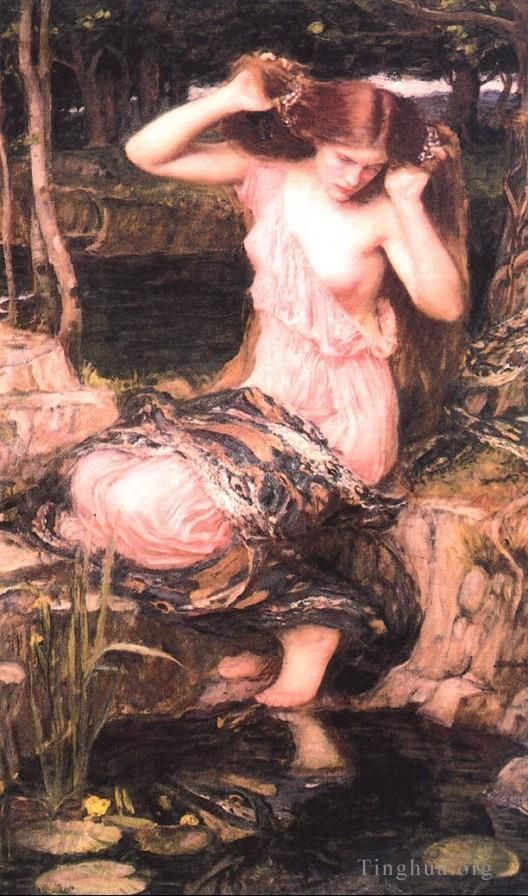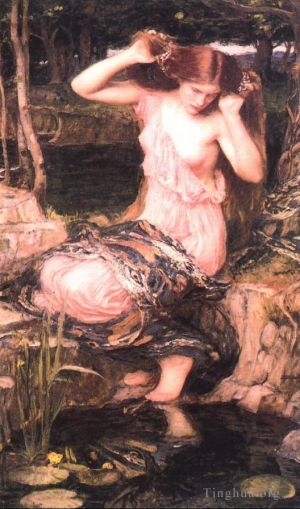Lamia
John William Waterhouse
- Price: Price on Request
- Art Type: Oil Painting
- Size:
- English Comments: 0
- International Comments: 0
- Creating Date:
- Introduction and Works of John William Waterhouse >>
Keywords:
Lamia
Work Overview
- Lamia
John William Waterhouse
Date 1909
Medium oil on canvas
Dimensions 36 × 22.5 in (91.4 × 57.2 cm)
In ancient Greek mythology, Lamia (/ˈleɪmiə/; Greek: Λάμια) was a beautiful queen of Libya who became a child-eating daemon. Aristophanes claimed her name derived from the Greek word for gullet (λαιμός; laimos), referring to her habit of devouring children.[1] Modern scholarship reconstructs a Proto-Indo European stem *lem-, "nocturnal spirit", whence also lemures.
The English poet John Keats published his narrative poem "Lamia" in 1820.[28] The poem has influenced later works of Western literature. Elizabeth Barrett Browning's epic poem "Aurora Leigh" contains numerous references to Lamia, including Book One in which at times a portrait of her dead mother appears as a Lamia, and Book Six in which she repeatedly refers to Lady Waldemar as Lamia. Booker Prize winner A. S. Byatt's 1998 collection of short fiction, Elementals: Stories of Fire and Ice, contains a short story entitled "A Lamia in the Cévennes", which references Keats' poem.[29] The character Brawne Lamia appears in Dan Simmons' novels Hyperion and The Fall of Hyperion. The works of John Keats feature heavily in the novels.[30][31] In Neil Gaiman's TV series and novel Neverwhere a character named Lamia is a "Velvet", a type of warmth-drinking vampire. The name is also given to the witch queen in the film adaptation of Gaiman's novel Stardust (a character who goes unnamed in the book).
In John Connolly's book of short stories entitled Night Music: Nocturnes Volume 2,[32][full citation needed] the Lamia is a half-woman half snake or scorpion-like creature that helps victimized women gain revenge upon the men that rape them and escape the justice of the courts. It is unclear how the Lamia feeds upon the men, but she begins the ritual by forcing her snake-like tail down the throats of the men until their mouths split and the life leaves their bodies.
- Copyright Statement:
All the reproduction of any forms about this work unauthorized by Singing Palette including images, texts and so on will be deemed to be violating the Copyright Laws.
To cite this webpage, please link back here.
- >> English Comments
- >> Chinese Comments
- >> French Comments
- >> German Comments
- >>Report
- The lady of shalott study JW
- Apollo and daphne FR
- The SirenA Arthurian
- Penelope and the Suitors
- The Awakening of Adonis
- Mariana in the South
- Sweet summer
- 5 Ophelia
- Pandora
- The Magic Circle
- Crystal Ball
- Ulysses and the Sirens
- Flora
- Sleep and his half brother death JW
- Miranda The Tempest
- The Flower Picker JW
- The Lady of Shalott
- At Capri
- Flora and the zephyrs
- Portrait of Phyllis Waterlo
- Flora JW
- Destiny
- Narcissus JW
- The annunciation
- Thisbe
- Lamia
- Psyche Entering Cupids Garden
- Circe offering the Cup to Ulysses
- A Naiad or Hylas with a Nymph John William Waterhous
- In the Peristyle
- Saint Cecilia
- Two Little Italian Girls by a Village
- The household gods JW
- La belle dam sans mercie
- Maidens picking study
- Gather ye rosebuds study JW
- Boreas
- My Sweet Rose
- Juliet JW
- After the dance JW
- Diogenes
- Circe Invidiosa
- The Danaides
- Portrait of Mrs Charles Schreiber
- The Lady of Shalott
- The Favourites of the Emperor Honorius
- Gathering almond blossoms JW
- Echo and Narcissus
- Ophelia
- Fair Rosamund
- Gathering summer flowers in a devonshire garden JW
- Gather ye rosebuds
- The Sorceress
- Miss Margaret Henderson
- Tristan and Isolde Sharing the Potion
- Miss Betty Pollock
- Listening to His Sweet Pipings
- Dante and Beatrice
- Windswept
- Dolce Far Niente
- Nymphs finding the head of orpheus study JW
- Study For The Lady Of Shallot
- 5
- A Sick Child Brought into the Temple of Aesculapius
- Knight
- Women with water jugs
- The lady clare JW
- The Necklace
- Vanity
- Mariamne
- Consulting the Oracle
- Hylas and the Nymphs
- A Mermaid
- At the Shrine
- The Orange Gatherers
- The enchanted garden
- The remorse of nero after the murdering of his mother JW
- Saint Eulalia
- Psyche Opening the Golden Box
- Ariadne
- Cleopatra JW
- Jason and medea FR
- Gather ye rosebuds while ye may 1909
- Study For Gather Ye Rosebuds While Ye May
- Hylas and the nymphs study JW
- StudyfortheLadyClareSmall









 Singing Palette
Singing Palette